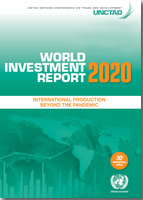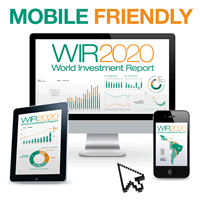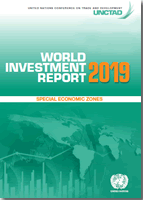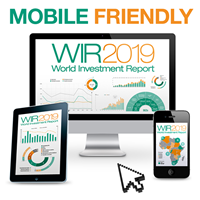World Investment Report 2020
Global flows of foreign direct investment (FDI) will be under severe pressure this year as a result of the COVID-19 pandemic. These vital resources are expected to fall sharply from 2019 levels of $1.5 trillion, dropping well below the trough reached during the global financial crisis and undoing the already lackluster growth in international investment over the past decade. Flows to developing countries will be hit especially hard, as export-oriented and commodity-linked investments are among the most seriously affected.
The consequences could last well beyond the immediate impact on investment flows. Indeed, the crisis could be a catalyst for a process of structural transformation of international production this decade, and an opportunity for increased sustainability, but this will depend on the ability to take advantage of the new industrial revolution and to overcome growing economic nationalism. Cooperation will be crucial; sustainable development depends on a global policy climate that remains conducive to cross-border investment.
The World Investment Report, now in its thirtieth year, supports policymakers by monitoring global and regional FDI trends and documenting national and international investment policy developments. This year’s Report naturally takes stock of the COVID-19 crisis. It also includes a new chapter, added at the request of the UN General Assembly, on investment in the Sustainable Development Goals.
This analysis shows that international private sector flows to four out of ten key SDG areas have failed to increase substantially since the adoption of the goals in 2015. With less than a decade left to the agreed deadline of 2030, this makes it all the more important to evaluate the implications of the expected changes in the investment landscape over the coming years.
As such, this year’s World Investment Report is required reading for policymakers and an important tool for the international development community. I commend its information and analysis to a wide global audience.
Источник
Homepage
Main Slider
World Investment Report 2020
Global flows of foreign direct investment (FDI) will be under severe pressure this year as a result of the COVID-19 pandemic. These vital resources are expected to fall sharply from 2019 levels of $1.5 trillion, dropping well below the trough reached during the global financial crisis and undoing the already lackluster growth in international investment over the past decade. Flows to developing countries will be hit especially hard, as export-oriented and commodity-linked investments are among the most seriously affected.
The consequences could last well beyond the immediate impact on investment flows. Indeed, the crisis could be a catalyst for a process of structural transformation of international production this decade, and an opportunity for increased sustainability, but this will depend on the ability to take advantage of the new industrial revolution and to overcome growing economic nationalism. Cooperation will be crucial; sustainable development depends on a global policy climate that remains conducive to cross-border investment.
The World Investment Report, now in its thirtieth year, supports policymakers by monitoring global and regional FDI trends and documenting national and international investment policy developments. This year’s Report naturally takes stock of the COVID-19 crisis. It also includes a new chapter, added at the request of the UN General Assembly, on investment in the Sustainable Development Goals. This analysis shows that international private sector flows to four out of ten key SDG areas have failed to increase substantially since the adoption of the goals in 2015. With less than a decade left to the agreed deadline of 2030, this makes it all the more important to evaluate the implications of the expected changes in the investment landscape over the coming years.
As such, this year’s World Investment Report is required reading for policymakers and an important tool for the international development community. I commend its information and analysis to a wide global audience.
Источник
World Investment Report 2019
The World Investment Report supports policymakers by monitoring global and regional foreign direct investment trends and documenting national and international investment policy developments.
The policy chapter of this year’s report takes stock of efforts being made towards the reform of international investment agreements and surveys new measures.
Inclusive sustainable development depends on a global policy environment that is conducive to cross-border investment.
Last year, global flows of foreign direct investment fell by 13 per cent, to $1.3 trillion. This represents the lowest level since the global financial crisis and underlines the lack of growth in international investment this decade.
The significant acceleration required to meet the investment needs associated with the Sustainable Development Goals is not yet apparent. We need to raise ambition on climate action, address debt vulnerabilities and reduce trade tensions to foster environments that are conducive to scaling up long-term and sustainable investments.
Among the most important instruments for attracting investment are Special Economic Zones. The number of zones around the world has grown rapidly this decade to more than 5,000, with many more planned.
This World Investment Report provides an overview of the global SEZ landscape and offers advice on how to respond to fundamental challenges for zones posed by the sustainable development imperative, the new industrial revolution and changing patterns of international production.
I commend this year’s World Investment Report for both industrial and investment policymakers, and as an important tool for the international development community.
Источник
Homepage
World Investment Report 2020
INTERNATIONAL PRODUCTION BEYOND THE PANDEMIC
Global flows of foreign direct investment (FDI) will be under severe pressure this year as a result of the COVID-19 pandemic. These vital resources are expected to fall sharply from 2019 levels of $1.5 trillion, dropping well below the trough reached during the global financial crisis and undoing the already lackluster growth in international investment over the past decade. Flows to developing countries will be hit especially hard, as export-oriented and commodity-linked investments are among the most seriously affected.
The consequences could last well beyond the immediate impact on investment flows. Indeed, the crisis could be a catalyst for a process of structural transformation of international production this decade, and an opportunity for increased sustainability, but this will depend on the ability to take advantage of the new industrial revolution and to overcome growing economic nationalism. Cooperation will be crucial; sustainable development depends on a global policy climate that remains conducive to cross-border investment.
The World Investment Report, now in its thirtieth year, supports policymakers by monitoring global and regional FDI trends and documenting national and international investment policy developments. This year’s Report naturally takes stock of the COVID-19 crisis. It also includes a new chapter, added at the request of the UN General Assembly, on investment in the Sustainable Development Goals. This analysis shows that international private sector flows to four out of ten key SDG areas have failed to increase substantially since the adoption of the goals in 2015. With less than a decade left to the agreed deadline of 2030, this makes it all the more important to evaluate the implications of the expected changes in the investment landscape over the coming years.
As such, this year’s World Investment Report is required reading for policymakers and an important tool for the international development community. I commend its information and analysis to a wide global audience.
Key Messages
Global FDI flows are forecast to decrease by up to 40 per cent in 2020, from their 2019 value of $1.54 trillion. This would bring FDI below $1 trillion for the first time since 2005. FDI is projected to decrease by a further 5 to 10 per cent in 2021 and to initiate a recovery in 2022. A rebound in 2022, with FDI reverting to the pre-pandemic underlying trend, is possible, but only at the upper bound of expectations.
Prospects depend on the duration of the health crisis and on the effectiveness of policy interventions to mitigate the economic effects of the pandemic. Geopolitical and financial risks and continuing trade tensions add to the uncertainty.
The lockdown measures are slowing down existing investment projects. The prospect of a deep recession will lead MNEs to re-assess new projects. Policy measures taken by governments during the crisis include new investment restrictions. Starting in 2022, investment flows will slowly recover, led by GVC restructuring for resilience, replenishment of capital stock and recovery of the global economy.
The top 5,000 MNEs worldwide, which account for most of global FDI, have seen expected earnings for the year revised down by 40 per cent on average, with some industries plunging into losses. Lower profits will hurt reinvested earnings, which on average account for more than 50 per cent of FDI.
Both new greenfield investment project announcements and cross border mergers and acquisitions (M&As) dropped by more than 50 per cent in the first months of 2020 compared with last year. In global project finance, an important source of investment in infrastructure projects, new deals fell by more than 40 per cent.
Despite the drastic decline in global FDI flows during the crisis, the international production system will continue to play an important role in economic growth and development. Global FDI flows will remain positive and continue to add to the existing FDI stock, which stood at $37 trillion at the end of 2019.
Developing economies are expected to see the biggest fall in FDI because they rely more on investment in global value chain (GVC)-intensive and extractive industries, which have been severely hit, and because they are not able to put in place the same economic support measures as developed economies.
This is significantly more than those to North America and other developed economies (with falls of 20 to 35 per cent on average), because the region entered the crisis on a relatively more fragile footing. In 2019, flows to developed economies as a group increased by 5 per cent to $800 billion.
The negative trend will be exacerbated by low commodity prices. In 2019, FDI flows to Africa already declined by 10 per cent to $45 billion.
Due to their vulnerability to supply chain disruptions, the weight of GVC-intensive FDI in the region and global pressures to diversify production locations. FDI is projected to fall by 30 to 45 per cent. In 2019, FDI flows to the region declined by 5 per cent, to $474 billion, despite gains in South-East Asia, China and India.
Investment prospects are bleak because the pandemic compounds political turbulence and structural weaknesses in several economies. The industry profile of FDI in the region also makes it vulnerable. In 2019, FDI in Latin America and the Caribbean grew by 10 per cent to $164 billion.
The decline will largely undo a recovery of FDI to the region in 2019 (up 59 per cent to $55 billion) after several years of low inflows.
Many least developed countries (LDCs) are dependent on FDI in extractive industries, many small island developing States are dependent on investment in tourism, and landlocked developing countries are disproportionally affected by supply chain blockages.
Several multilateral groupings, including the G20, have issued declarations in support of international investment. More than 70 countries have taken measures either to mitigate the negative effect on FDI or to shield domestic industries from foreign takeovers.
On the one hand, it may solidify the shift towards more restrictive admission policies for foreign investment in strategic industries. On the other, it may trigger increased competition for investment as economies seek to recover from the crisis.
Overall, 54 economies introduced at least 107 measures affecting foreign investment in 2019; three-quarters were in the direction of liberalization, promotion and facilitation, with developing countries and emerging economies in Asia most active.
In 2019, the number of IIA terminations (34) exceeded the number of new IIAs (22) for the second time. This brought the total to 3,284 IIAs and 349 effective terminations.
Most of the 55 publicly known ISDS cases initiated in 2019 were brought under IIAs signed in the 1990s or earlier. ISDS tribunals rendered at least 71 substantive decisions.
Nearly all new IIAs contain features in line with UNCTAD’s Reform Package for the International Investment Regime, with the preservation of States’ regulatory space being the most frequently seen area of reform. To support the IIA reform process, UNCTAD will launch its IIA Reform Accelerator later in 2020.
During which international production saw two decades of rapid growth followed by one of stagnation. Flows of cross-border investment in physical productive assets stopped growing in the 2010s, the growth of trade slowed down and GVC trade declined.
The 2010s were only the quiet before the storm. The crisis caused by the COVID-19 pandemic arrives on top of existing challenges to the system of international production arising from the new industrial revolution (NIR), growing economic nationalism and the sustainability imperative.
These dimensions are the degree of fragmentation and the length of value chains, the geographical spread of value added, and the governance choices of MNEs that determine the prevalence of arm’s-length trade versus FDI.
They are robotics-enabled automation, enhanced supply chain digitalization and additive manufacturing. Each will have distinct effects on the length, geographical distribution and governance of GVCs.
The policy environment for trade and investment is trending towards more interventionism, rising protectionism and a shift away from multilateral to regional and bilateral frameworks.
They are at times mutually reinforcing, they occasionally push in opposite directions and they will play out differently across industries and geographies. Depending on the starting point of individual industries – their archetypical international production configurations – they will tend to favour one of four trajectories.
Although the different trajectories show that the expected transformation of international production is not unidirectional, overall, the trends show a system under severe pressure with heightened risks of a dismantling and hollowing-out of GVCs and declining cross-border investment in productive assets.
Challenges include increased divestment, relocations and investment diversion, and a shrinking pool of efficiency-seeking investment, implying tougher competition for FDI. While opportunities arising from the transformation include attracting investors looking to diversify supply bases and building redundancy and resilience.
First, from a focus on export-oriented efficiencyseeking investment in narrowly specialized GVC segments to an “export-plus-plus” focus – plus investment in production for regional markets, plus investment in a broader industrial base.
For the past three decades international production and the promotion of export-oriented manufacturing investment have been the pillars of development and industrialization strategies of most developing countries.
UNCTAD first estimated investment requirements for the SDGs in WIR14, identifying 10 relevant sectors (encompassing all 17 SDGs) and estimating an annual investment gap of in developing countries of $2.5 trillion.
UNCTAD estimates that funds dedicated to investment in sustainable development have reached $1.2-1.3 trillion today. However, most of these funds are invested in developed countries (e.g. in renewable energy).
In the first quarter of 2020, social bonds related to COVID-19 crisis relief raised $55 billion, exceeding the total value of social bonds issued in all of 2019. Stock exchanges actively support the fast-growing COVID-19 response bond market, for example by waiving listing fees.
Progress on investing in the SDGs is not just about mobilizing funds and channeling them to priority sectors. It is also about integrating good environmental, social and governance (ESG) practices in business operations to ensure positive investment impact.
More than 150 countries have adopted national strategies on sustainable development or revised existing development plans to reflect the SDGs.
A new set of global actions to facilitate a “Big Push” in private sector investment in the SDGs is urgently needed. Building on the six transformative actions proposed in its Investment Policy Framework for Sustainable Development, UNCTAD’s new Action Plan combines several policy instruments to provide an implementation framework for the UN Secretary-General’s Strategy for Financing the 2030 Agenda for Sustainable Development.
Источник






